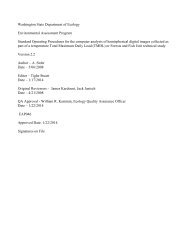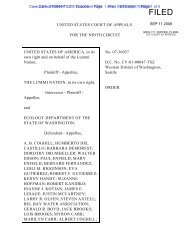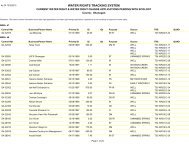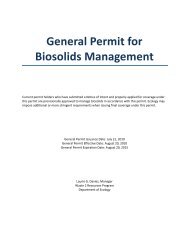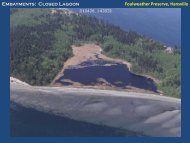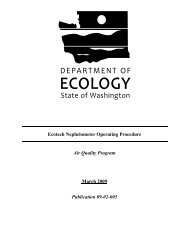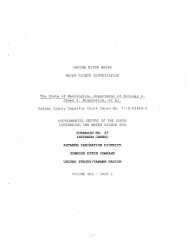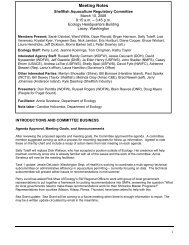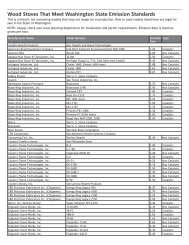WRIA 62 WMP 032305 - Washington State Department of Ecology
WRIA 62 WMP 032305 - Washington State Department of Ecology
WRIA 62 WMP 032305 - Washington State Department of Ecology
You also want an ePaper? Increase the reach of your titles
YUMPU automatically turns print PDFs into web optimized ePapers that Google loves.
March, 2005 -46- 023-1289-003.3040<br />
Federal District Courts ruling. The current provisions <strong>of</strong> the 2000 National Marine Fisheries Service<br />
Biological Opinion will remain in place until a new Biological Opinion is finalized. Based on review<br />
<strong>of</strong> the strategies and actions listed in the 2000 Biological Opinions, the Action Agencies (i.e., the<br />
Army Corps <strong>of</strong> Engineers, US Bureau <strong>of</strong> Reclamation and Bonneville Power Administration) have<br />
developed the following priorit ies (in order) for flow management and reservoir operation:<br />
1. Operate storage reservoirs (Hungry Horse and Libby) to meet minimum flow and ramp rate<br />
criteria for resident fish;<br />
2. Refill the storage projects by June 30 to provide summer flow augmentation. A la te<br />
snowmelt run<strong>of</strong>f may delay refill in order to avoid excessive spill;<br />
3. Operate storage projects to be at their April 10 flood control elevations to increase available<br />
flows for spring flow management; and,<br />
4. Provide fall and winter flows for chum salmon spawning and incubation.<br />
The Biological Opinions also acknowledge the concept <strong>of</strong> adaptive management so that the operation<br />
<strong>of</strong> the system should be adjusted based on acquired knowledge about current conditions and effects <strong>of</strong><br />
management actions (as opposed to following a rigid set <strong>of</strong> rules).<br />
4.1.4.1.1.1 Hungry Horse Dam<br />
Hungry Horse Dam and reservoir was built in 1952 with the purpose <strong>of</strong> hydroelectric power<br />
generation. It is managed by the US Bureau <strong>of</strong> Reclamation (BOR) as a part <strong>of</strong> the “main control<br />
plan” system <strong>of</strong> reservoirs in the Federal Columbia River Power System. The reservoir itself has a<br />
sizable storage capacity, and currently operates with more interest in water storage and flood control<br />
than for power generation. More than five times the power that can be produced at Hungry Horse can<br />
be produced by downstream dams, so release levels try to be consistent with downstream needs.<br />
A 2000 Biological Opinion by the National Marine Fisheries Service and the US Fish and Wildlife<br />
Service determined that conditions downstream <strong>of</strong> the dams in the Columbia River Power System<br />
needed to be improved for endangered fish species. In response to this biological opinion, in 2002,<br />
Hungry Horse dam began to operate under a new interim flow plan, called VARQ (for variable<br />
discharge). This flow plan will not become permanent until the completion <strong>of</strong> an EIS (scheduled for<br />
2005). Currently, Libby and Grand Coulee Dams are also operating under a VARQ interim flow<br />
plan.<br />
In 2000, a lawsuit between the National Wildlife Federation and National Marine Fisheries Service<br />
(NMFS) forced the 2000 Biological Opinion to resolve some cited deficiencies. A new Biological<br />
Opinion addressing these concerns was released September 9, 2004 and was available for public<br />
comment until October 8, 2004. Operations at Hungry Horse continue working under the 2000<br />
Biological Opinion until its deficiencies are resolved through the completion <strong>of</strong> the 2004 Biological<br />
Opinion.<br />
Currently, the US Bureau <strong>of</strong> Reclamation (BOR) and the Army Corps <strong>of</strong> Engineers (ACOE) are<br />
conducting an EIS on VARQ for Hungry Horse, Libby, and Grand Coulee. Through the EIS process,<br />
the BOR and ACOE have initiated or completed a variety <strong>of</strong> studies evaluating the potential impacts<br />
<strong>of</strong> various flood control and fish operations at Libby and Hungry Horse. One <strong>of</strong> these studies<br />
compares the VARQ and standard flood control procedures for Hungry Horse Reservoir and<br />
describes the associated hydrologic effects downstream (USBOR, 2004). This study concludes that:<br />
<strong>WRIA</strong> <strong>62</strong> <strong>WMP</strong> <strong>032305</strong>



